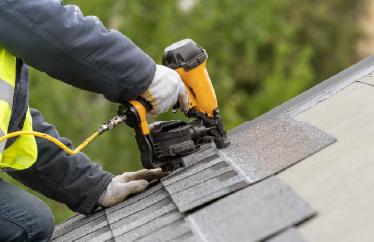A Guide to Eco-Friendly Landscaping

Though you may have turned up your nose to a day of yard work when you were young, if you now find yourself warming up to the idea, you just might be a homeowner. And there are a lot of reasons to get started. Not only is landscaping a great workout, but it can also increase your home’s worth by upping its curb appeal. If you do it right, you can even help the environment as well.
So the next time you start planning out your cleaning and home maintenance to-do list, add some yard updates to benefit you, the earth and your wallet. Even if you’ve never had a green thumb or just want more direction on the best updates to help the environment, let us walk you through some easy landscaping ideas you can get started on for your home.
The benefits of landscaping
The benefits of landscaping far outweigh any drawbacks regarding physical labor. We mentioned some of the improvements above, such as boosting your home’s curb appeal and protecting the environment but don’t just take our word for it. There are plenty of studies out there to back up our claims, and we’ve rounded up a few of them for you here to help seal the deal.
- Landscaping improves your quality of life by encouraging you to spend more time outdoors.
- An article from Yale Environment highlights that spending time outdoors can lead to lower blood pressure, reduced anxiety and an improved mood.
- It lowers the cost to heat and cool your home.
- According to The Ground Guys, planting trees on the south and west sides of your home can lower attic temperature by as much as 40 degrees.
- A Cornell University study estimates an eco-friendly landscape can reduce utility bills by 10% to 30%.
- Landscaping elements such as proper drainage and retaining walls can help protect your yard and extend its lifespan.
- Learn how to build a retaining wall with this guide from The Family Handyman.
- Native plants require less upkeep, use fewer resources and provide adequate shelter for local wildlife, according to the National Audubon Society.
- Yard updates can increase your property value anywhere from 5% to 13%, according to SFGate.
8 eco-friendly landscaping ideas to add to your home
When it comes to the best landscaping plan for your home, what benefits both your lawn and the environment will vary. Depending on your local climate, experience level and how much upkeep you want to take on, you may not want to try out every single idea on this list.
Though given just how simple some of these ideas are, you’re sure to find something fun to tackle. Just be careful where you dig once you get started on a new project — damaging a service line in your yard can be costly.
1. Try xeriscaping
Xeriscaping is a type of landscaping that requires little to no maintenance, water or upkeep. Not only does this make maintaining your yard easier, but it also helps reduce the amount of water you use regularly.
To properly xeriscape, you’ll want to first determine if you’re in a good location for this type of lawn. Xeriscaped lawns do well in hot, drought-prone areas such as Arizona, New Mexico or Texas. If you think your home is a good fit, try out any of the following xeriscaping elements to create an easy and beautiful yard.
- Replace grass with rocks, sand or mulch.
- Include low-water plants and trees such as cacti, succulents and crape myrtles.
- Put plants with higher water requirements together to reduce water waste.
- Install dedicated walkways to extend the life of your plants.
2. Add rainwater bins
Want to reduce your water bill, but love your garden too much to xeriscape it? There’s a solution for that. Rainwater bins work by collecting rainwater from your gutters and storing it for use later on so that you don’t have to reach for the hose to keep your veggies happy. Plus, it helps keep water from collecting by your home, which can damage the foundation.
While there are many more complicated (and expensive) rainwater harvesting bins out there, all you really need is a plastic tub with a spout at the bottom to connect your hose. Put it underneath your drain spout, attach a cover to keep bugs out and be ready to see those savings on your utility bill start rolling in.
3. Include climate-friendly vegetation
To make your yard more eco-friendly, you have to work with the weather you’ve got. So if you live in an area prone to rain, you’ll want to plant vegetation that thrives in that area, such as royal ferns and forget-me-not flowers. If you live in a sunnier and drier climate, cacti and agave should do the trick.
With climate-friendly vegetation, your yard will be beautiful year-round. Since the plants are designed to survive in your climate, they’ll last longer, saving you from the painstaking work of redoing the yard every year.
4. Install a green roof
If you have a small yard or just want to take your eco-friendly home to the next level, look no further than your home’s structure. A green roof is a great way to insulate your home, extend the life of your roof and reduce rainwater runoff.
To create a green roof, first you need to determine what type of garden you want. If you don’t want to keep up with maintenance, you can plant a shallow garden with plenty of perennials and native plants. If you want more shade and don’t mind the upkeep, you can create a bigger garden to host large shrubs and trees that will block out more sunlight. Learn more about how to install a green roof from This Old House.
5. Ditch the grass
As common as a green, grassy lawn may be, it uses a lot of water. Reduce your water usage (and time mowing your lawn) by ditching the grass altogether. You can go the xeriscape route and lay down sand or rocks in your front yard. Or you can let nature do its thing and use a more natural ground covering like moss, clover or ornamental grass that doesn’t require much upkeep.
To make your lawn look more traditional, you can also install turf to replace your grass. Turf has come a long way since its plastic, painful past and now looks more realistic than ever. Not only does turf require no water or upkeep, but it also helps the soil beneath it regenerate quicker than its natural counterparts. Just make sure to purchase turf made out of recyclable material to ensure your yard is truly eco-friendly.
6. Install automatic sprinklers
Automatic sprinklers and drip irrigation are not only convenient, but they help save water too. Automatic sprinklers help ensure your lawn gets the water it needs, even if you're out of town. This means you don’t have to worry about buying new plants if your old ones die cause you forgot to bring out the hose (you can even control your sprinklers with apps on your phone).
Drip irrigation systems, while not as intense as sprinklers, provide a more consistent water source. They also target plants’ roots better, ensuring they can grow more resilient against the natural elements. But a word of caution if you have solar panels installed in your yard, make sure that your sprinklers won’t interfere with their electrical system when they’re in use.
7. Start composting
Feed your new landscape and keep it happy with fertilizer made from compost. If your city doesn’t have its own composting system, you can easily create your own in your backyard. All you need are food scraps, lawn clippings and water. It takes some time, but soon you’ll have a lot of fertilizer chock-full of nutrients perfect for newly landscaped lawns or vegetable gardens.
Unsure how to get started on your composting system? Learn from the experts over at Better Homes and Gardens.
8. Make a pollinator garden
Help endangered species thrive by planting a garden that will attract pollinating insects such as bees and butterflies. Since many pollen-filled plants feature beautiful flowers, it’s a win-win for everyone involved. Planting native and perennial flowers is an easy way to create a low-maintenance garden. But regardless of where you live, the following plants will help bring in plenty of new pollinator friends to your home. Not into insects? You could also try birdscaping to attract beautiful birds of all kinds to your front and back yard.
- Bee Balm
- Catmint
- Dandelions
- Daisies
- Garden Thyme
- Lavender
- Milkweed
- Sunflowers

Beautifying your outdoor space is good for your mind, your wallet and the environment. And if you plan on selling your home soon, a few quick landscaping tricks can boost your curb appeal and increase the value of your home. Just make sure to update your home insurance policy with this new value so that you're properly protected.



